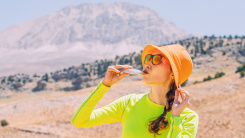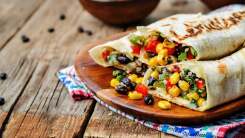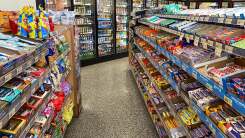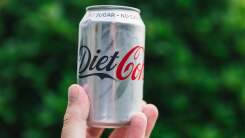What (and When) to Eat on a Long Run

Watch a marathon, and you’ll see runners sucking down packets of goo to keep them going as the hours tick by. If you’ve set your sights on a marathon, a half-marathon, or any long-distance endurance event, you’ll benefit from fueling on the go as well. But how long a run are we talking, how often do you need to eat, and what do you need to eat? Here’s your instruction manual.
Why eat on long runs?
Of the three main macronutrients—fats, carbs, and protein—carbs make the biggest difference when it comes to exercise performance. Your body is always burning fat at some level (even when you’re asleep), but the harder you work, the more carbs it wants to shovel into the furnace.
Our muscles store carbs in a form called glycogen. If you’ve ever “carb loaded” with a pasta dinner, you were filling up your glycogen stores. We also have carbs floating through our bloodstream—this is what “blood glucose” means. During exercise, our bodies use both of these sources.
For short workouts, we have plenty of glycogen to carry us through. But for a multi-hour run (or hike or bike ride), we’ll need to supply more carbs so our muscles can keep working at our desired pace. Eating during a workout, to improve or maintain performance during that workout, is often referred to as “fueling.”
Do you need to fuel on long runs? Technically, no. Our bodies can work for a long time whether we eat or not. But as our internal carb supplies diminish, we’ll feel sluggish and we’ll slow down. We may also have a harder time recovering from that run afterward. If you usually do long runs on an empty stomach, try fueling for your next one. You’ll notice a big difference in how you feel.
How long of a run requires fueling?
Many athletes will draw the line at about 90 minutes: if your workout is shorter than that, no need to eat on the go. If you’ll be working for 90 minutes or more, that’s when you should pack some gels (or other foods, as we’ll discuss below).
But there’s room for experimentation. You don’t have to forgo the fueling if your run is 89 minutes. In fact, if you’re preparing for a race, you may want to practice fueling even on shorter (say, 60-minute) runs just to get into the habit and give yourself more opportunities to see what works for you.
How much do I need to eat on a long run?
The general recommendation is to aim for 30 to 60 grams of carbohydrate per hour. Most people will naturally go for the lower end of this range; one gel packet per hour will only give you about 22 grams.
But research shows that people tend to feel and perform better when they have more carbs. Three gels per hour would be 66 grams of carbs, and that would be fine. (Some cyclists have gone well above that range with good results, but cyclists also don’t have to deal with their belly sloshing around like runners do.)
If you’re new to fueling, you can start with the lower end of the range if you like. A gel every 45 minutes may be a good place to start.
You’ll also want to make sure to start with some carbs already in your belly. Some runners like to take a gel (or their preferred fuel source) at the start line; I’ll do that on race days but for training days I just make sure to have a carby breakfast before heading out for my long run.
What makes a food good for endurance fueling?
The simple answer is that we want carbs that digest quickly. Glucose, a sugar, is the carb that we use most readily. Starches—like what you find in bread, rice, and potatoes—break down easily into glucose, so they’re a good source. Sugar, in the sense of table sugar, contains glucose and fructose. (There’s evidence suggesting that we can absorb a mix of sugars better than if we only had one type of sugar, so many sports nutrition products will use a mix.)
The ideal foods to eat during (or immediately before) endurance exercise:
-
Contain carbs in the form of sugar or starches
-
Don’t contain much fat, fiber, or protein (because these can slow down digestion—we want those carbs fast)
-
Can be mushed around for hours in a pocket and still be edible
-
Agree with your stomach
That last one is important! Stomachs vary, so what works for one runner may make another queasy. I’ve never had trouble with any of the standard options (which we’ll discuss in a moment), but I still wouldn’t try something on race day that I hadn’t tested in training—just in case.
Can you fuel with drinks?
There are sports drinks that say they contain enough carbs to fuel your training. You can fuel with drinks, but there’s a problem with many of them.
When you spend hours chugging certain sports drinks, your intestines can get unhappy with the concentration of sugar water inside them. In other words, you’ll get what runners politely call “GI [gastrointestinal] distress.” This can take the form of burbling guts, farting, and—far more often than we’d like to admit—diarrhea.
The ratio of sugar to water seems to be what causes this. Full-strength Gatorade is notorious for setting off bouts of diarrhea if you drink enough of it. Water it down to half-strength, though, and you’ll likely be fine.
Remember that the marketing niche for most sports drinks is “provides electrolytes and tastes good,” not “will get you through a marathon without shitting your pants.” If you want your carbs in liquid form, look for something marketed toward athletes for that exact purpose, like Tailwind. Its sugar concentration is a lot easier on the gut.
Fueling options you can buy
The standard, simplest way of fueling, assuming money is no object, is to just get yourself a supply of gels. These are packets of carbohydrate goo (literally, one of the brand names is Gu) that fit the requirements above. Some popular brands include:
-
Gu Energy Gel (about $1.40 each)
-
Huma Chia Gel (about $2.40 each)
-
Science in Sport Gel (about $2.85 each)
-
Honey Stinger Gel (about $2 each)
Some gel flavors come with caffeine, and some don’t, so read the label to be sure you’re getting whichever you prefer. (Caffeine can improve athletic performance, but can also keep you up at night. You may want caffeinated gels for morning workouts but not evening ones, perhaps.)
If you’re wondering which brands or flavors taste the best, allow me to save you a lot of time and trial-and-error: They all suck. When you’re 12 miles into your long run, you’ll hate them all. I found the coffee and caramel flavors to be the least disgusting when I started, but at this point I’m beyond caring.
If you want something you can buy at a store, but that isn’t a gel, try these:
-
Honey Stinger Waffles, about $1.10/pack (they’re like stroopwafels)
-
Clif Bloks Energy Chews, about $1.55/pack
-
Jelly Belly Sport Beans, about $2/pack (I promise I am not making this up)
Each of these items contains about the same amount of carbs per package as the gels above, but be sure to check the label; they’re not exactly equivalent. The Honey Stinger Waffles also contain slightly more calories than the others for a similar amount of carbohydrate, which may or may not matter to you.
Cheaper and less-processed options for long run fueling
When you run a lot, you can easily spend a ton of money on gels and other products. But remember what makes good run fuel—it doesn’t have to be a commercially processed, sport-scientist-optimized packaged product. It can just be any old food with carbs. (That said, we will attempt to forget Heinz’s push to make ketchup packets into running fuel.)
Some good grocery-store options, which I’ll list with carb content so you can compare to the 20-25 grams in a typical gel:
-
Haribo gummy bears, 28 grams of carbs, $0.53 per pack
-
Daelmans stroopwafels, 24 grams of carbs, $1.03 per waffle
-
Brach’s jelly beans, 26 grams of carbs per 10 beans, about $0.80
You can also get a similar amount of carbs from:
-
A medium banana – assuming you’re OK with that much chewing, and that the banana wasn’t smushed en route.
-
Half a peanut butter and jelly sandwich – go light on the peanut butter or skip it entirely for easier digestion.
-
An ounce of raisins – some trail runners swear by dried fruit, but it has a higher fiber content than many of the items above.
-
Packets of honey or jam (two packets per serving) – note that these are free if you swipe them from your hotel’s breakfast bar when traveling.
-
Pouches of applesauce or baby food – check the label, since carb content varies.
Don’t forget that you can just look around your kitchen and grab whatever seems appetizing. Cookies may not be “optimal” running fuel, but they have fueled many a run. Just make sure to test out a new fuel on shorter runs before relying on it for a long run or race day.



